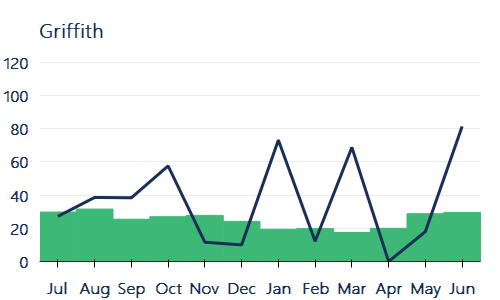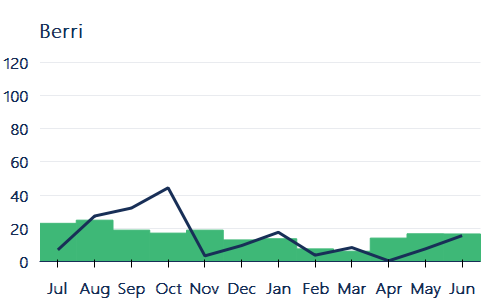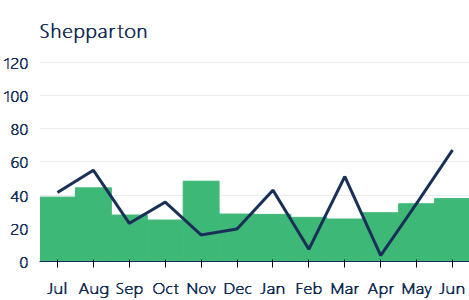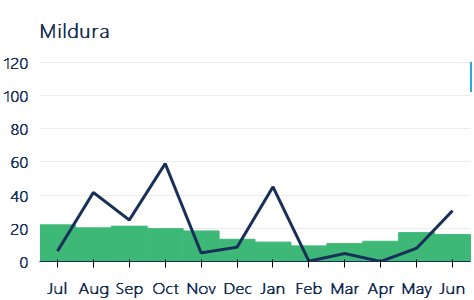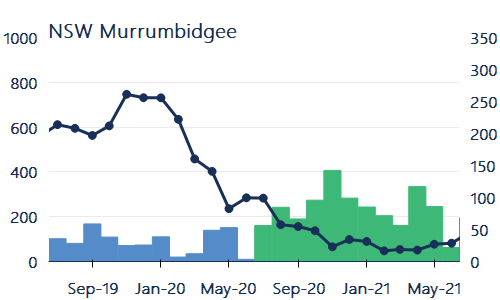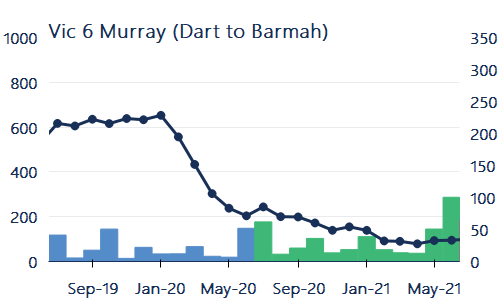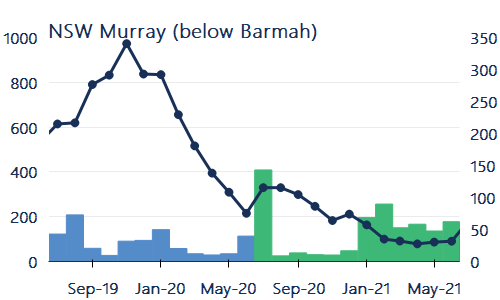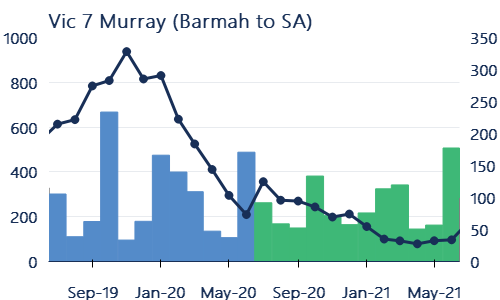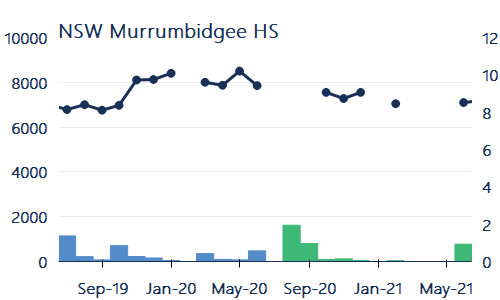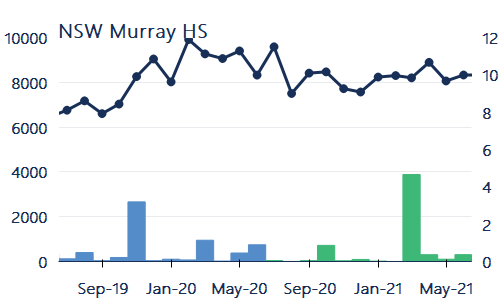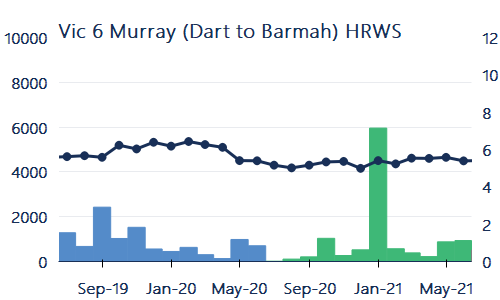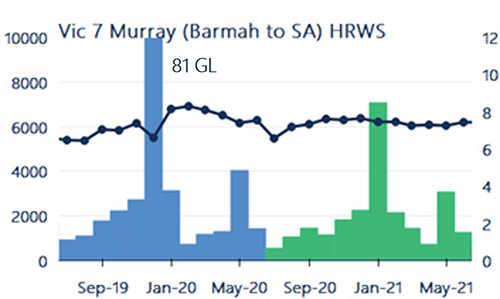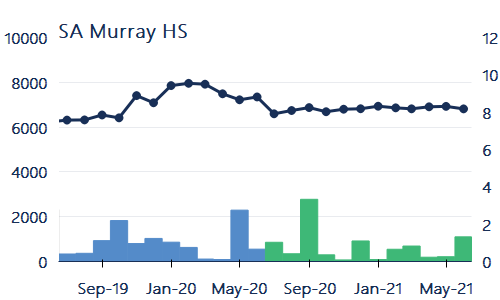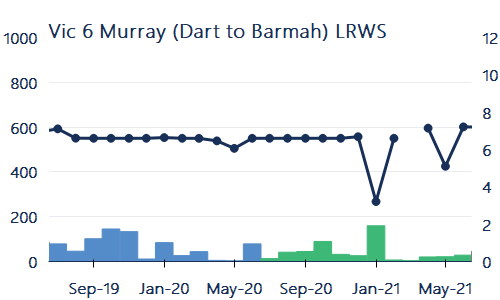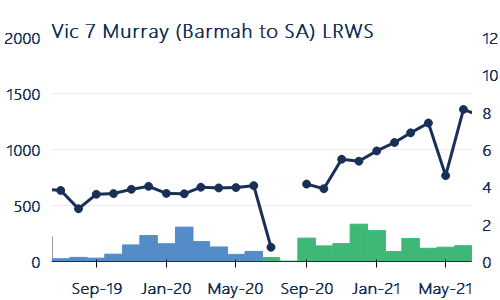Background
Australian water management has undergone a significant period of reform over the past three decades. The establishment of water markets has been a key component of this reform story.
Water markets are now an established part of agricultural, urban and environmental water policy, management and investment in Australia.
The Aither Water Markets Report provides an overview of current water market activity in the southern Murray–Darling Basin, compares market outcomes with recent years and comments on the future outlook.
Download the PDF here

About Aither
Our Water Market Services
We are a team of award-winning, independent water markets, policy, and infrastructure advisors.
Every day, we help businesses and governments make better decisions about scarce water resources.
We do this by providing high-quality information, insights and analysis that help our clients design and implement strategies for successfully participating in Australia’s water markets. Our team also provides policy, regulatory and infrastructure advisory services.
Whether you need custom-designed water strategies or assessments of your exposure to water-related risks and opportunities, we’ll help you make clear, informed and confident water decisions.
Executive Summary
Facts at a glance – 2020-21
- Estimated value of commercial allocation trade in major southern MDB trading zones: $189 million.
- Annual average southern MDB allocation prices: $95 per ML in NSW Murray (above Barmah) to $191 per ML in SA Murray.
- Estimated value of major southern MDB entitlements on issue (including environmental and Victorian water corporation holdings): $26.5 billion.
- Aither Entitlement Index (AEI) 30 June 2021: 251 points (up 6 per cent over 12 months).
- Value of total entitlement transfers: $744 million.
- Total volume of entitlement transfers or trades (outside of irrigation corporations): 239 GL (down 7 per cent on 2019-20).
- Entitlement market turnover: 4 per cent.
- Average annual high security and high reliability entitlement returns (sale of allocations): between 1 and 3 per cent.
Summary of 2020-21
2020-21 will be remembered as the first wet year after the driest 36 months on record for the southern Murray-Darling Basin (MDB). Regular rainfall and lower allocation prices than the last two water years brought welcome relief for irrigators across the Basin.
Allocation markets
- Large areas of the MDB received above average rainfall most months between July 2020 and March 2021. Regular rainfall and good inflows into storages improved water supply conditions in all systems across the southern MDB compared to the last three water years.
- Average water allocation prices started the water year just above $300 per ML, and then tumbled throughout the year as allocations to entitlements increased and timely in-crop rainfall arrived.
- Binding trade constraints in the first half of the season created price differentials between upstream zones and the lower Murray again. But, with increased water supply in all zones, the differentials were not as large as in 2019-20 (in absolute terms).
- The combination of high volumes of carryover from 2019-20, improved water availability in 2020-21, and water usage below budget for many permanent horticulturalists created the second largest volume of carryover in all major trading zones.
Entitlement markets
- Prices for high reliability and high security entitlements generally stabilised in 2020-21 after the price decreases between January and June 2020. This price stabilisation was likely underpinned by the strength of the Australian agricultural sector, and the long-term expectations of market participants.
- Market activity for low reliability and general security entitlements was again influenced by demand for carryover space. Increased returns from improved allocations to NSW general security entitlements also revived entitlement market activity.
- The 2020-21 price increases in low reliability and general security entitlements were the primary driver of the return to month-on-month increases in the Aither Entitlement Index between January and June 2021.
Facts at a glance – Outlook
- Comparison of 2020-21 and 2021-22 opening season allocations to consumptive users (excluding carryover): 600 GL more water allocated at opening of 2020-21.
- Estimated 2021-22 total volume of water available to southern MDB consumptive users before peak irrigation season under average inflows scenario (including carryover): approximately 5,300 GL.
- Bureau of Meteorology three-month rainfall outlook (August to October) for southern MDB: Above average.
- Current (early August 2021) southern MDB allocation prices: $65 to $120 per ML.
Outlook for 2020-21
At the start of 2021-22, the large volumes of carryover and favourable outlook for spring rain mean that many irrigation businesses are set for a successful year. Annual croppers will be gearing up for a big season and hoping that further inflows extend the good times for another year or two.
Allocation markets
- Quick increases in allocations to most entitlements in the southern MDB in the first six weeks of the water year mean many market participants can afford to be patient. As a result, allocation markets have generally been quiet.
- If average inflows eventuate from here (early August 2021), by peak irrigation season, consumptive water availability could be higher than the volume available by mid-December in 2020. If this happens, allocation prices could settle around or below prices seen in the final months of 2020-21. It will likely take a marked return to drier conditions to push prices up from current levels this water year, although the key driver to watch will be buying demand from annual croppers as summer approaches.
- With downstream trade opportunities closed, prices will be higher in the lower Murray than the upstream zones. But the 2021-22 price differentials will likely be relatively small in absolute terms because of the increased water availability in all zones.
- The key dynamics to watch are: (1) If irrigators need to draw on their carryover from 2020-21. With increased allocations to entitlements, and positive rainfall outlooks, conditions are set for there to be another year of high volumes of carryover which will mean many irrigators will be well placed entering 2022-23. (2) The timing of in-crop rainfall and summer temperatures. With large areas of winter crops planted, and promising rainfall and allocation outlooks likely to encourage summer crop planting, 2021-22 could be a high water usage year. Depending on how these factors combine, the drawdown on storages could be much larger than the last two water years. If it stays wet, then the good times will continue for another year.
Entitlement markets
- The long-term outlook for entitlement markets remains strong. However, compared to last year, key uncertainties that may have been creating caution among water market participants have eased.
- High reliability and high security entitlement prices seem to have stabilised, possibly reaching a new equilibrium after five years of rapid appreciation.
- Against the backdrop of firming commodity prices, low interest rates and a positive outlook for the Australian agricultural sector, there seems to be limited supply of high reliability and high security entitlements coming to market. If this continues, prices for these entitlements may start to increase.
- Demand for carryover space will likely continue to be a feature of water markets in the southern MDB. Many permanent horticulturalists still have immature plantings, and will continue to look for secure carryover space to cover their water needs. With limited supply of carryover space in the lower Murray, demand for all low reliability entitlements will likely continue.
- 2021-22 is likely to be a strong year for NSW general security entitlement values. Current allocations are already better than they were at the same time during the last three water years. This will support improved returns for general security entitlement holders.
1.1 Introduction
Now in its eighth year, the Aither Water Markets Report provides water market participants, advisors, investors, and policy professionals with an annual snapshot of recent water market drivers and activity in the southern Murray-Darling Basin (MDB) (Figure 1).
This year’s report highlights the key drivers of the lower water allocation prices observed in 2020-21 compared to the last three years, including:
- the 2020-21 La Niña event and increased allocations to general security entitlements.
- cooler summer conditions that meant many permanent horticulturalists’ water use was below budget.
- high volumes of carryover from 2019-20 that suppressed buying demand throughout the year.
We also draw attention to how low allocation prices and, therefore, lower returns for entitlement holders have not materially influenced high reliability and high security entitlement prices. After entitlement prices declined in early 2020, high reliability and high security entitlement prices generally stabilised in 2020-21. This stabilisation potentially indicates a maturing of the market and the long-term expectations of market participants.
As we look ahead from August 2021 (the time of writing), our outlook for 2021-22 explores how these factors may influence water markets in the southern MDB over the next 12 months.

Figure 1. Water trading zones in the southern Murray-Darling Basin.
Source: Aither, 2021.
Aither Entitlement Index
As the only index of its kind in Australia, the Aither Entitlement Index (AEI) provides a simple and reliable snapshot of water entitlement performance throughout the southern MDB.
Across the 2020-21 water year, the AEI increased by 6 per cent; the same percentage increase as in 2019-20. The AEI was relatively steady during the first six months of the water year (increasing 1.5 per cent). Then from December 2020 the AEI increased more than 4 per cent (Figure 2).
The Aither Entitlement Index tracks the performance (capital value) of a group of major water entitlements across the southern MDB.
Although the AEI has recovered most of the decline that took place in the second half of the 2019-20 water year, increases to low reliability and general security entitlement prices have been the primary driver of the return to an upwards trend. The AEI is currently 1 per cent below its all-time high set in January 2020. The Compound Annual Growth Rate of the AEI is 7 per cent since its inception in 2008.
Aither’s independent water market specialists update the AEI every month using our in-house southern Murray-Darling Basin water asset valuations. The AEI supports better decision making by providing irrigators, investors, banks and other water owners with a reliable benchmark to track the capital value performance of water portfolios and investments, and attract new investors.

Figure 2. Aither Entitlement Index, 2008-09 to 2020-21.
Source: Aither, 2021.
2.1 Climatic Conditions
Rainfall a welcome relief after the driest 36 months on record.
2020-21 will be remembered as the first wet year after the driest 36 months on record for the MDB (Bureau of Meteorology, 2020).
Wetter conditions across the MDB were driven by a moderate strength La Niña event. This meant that large areas of the MDB received above average rainfall most months between July 2020 and March 2021 (Figure 3).
La Niña also brought cooler temperatures. The 2020-21 summer was the coolest since 2011-12 in NSW and the coolest since 2004-05 in Victoria (Bureau of Meteorology, 2021a, 2021b). Increased rainfall and cooler temperatures meant many permanent horticulturalists’ water use was well down on water budgets.
Although 2020-21 was considerably wetter than the three previous water years, rainfall varied across the MDB, especially across the headwater catchments in the southern connected system. The headwater catchments of the Murrumbidgee received very much above average rainfall for the year. For example, Bowning, near Lake Burrinjuck, recorded the highest monthly total on record in August 2020 (181mm). Rain also came early in the season for the Murrumbidgee.
In contrast, the Victorian headwaters of the Murray and Goulburn systems received below average to average rainfall for the year. This rainfall variability heavily influenced differences in the timing of allocations to entitlements across the southern MDB.

Figure 3. Rainfall deciles for the Murray-Darling Basin, 1 July 2020 to 30 June 2021.
Source: Aither 2021. Based on Bureau of Meteorology, 2021.
2.2 Storages
2020-21 ends with the highest volume held in southern MDB storages since 2016-17.
After rainfall in early 2020 wet the catchments, good runoff meant that southern MDB storages began to replenish. At the start of the 2020-21 water year there was approximately 680 GL more water held in southern MDB storages compared to at the start of 2019-20.
The storages continued to fill, finally breaking the three-year trend of decreasing peak volumes. In 2020-21, water held in southern MDB storages peaked at 9,470 GL, 47 per cent higher than in 2019-20 (Figure 4).
Although the peak volume in 2020-21 did not exceed the peak volumes of 2016-17 and 2017-18, the drawdown was low for the second year in a row. Net drawdown in the irrigation season was less than 2,000 GL (Figure 4). The low annual net drawdown was driven by mild summer temperatures and timely in-crop rainfall. The influence of these factors can be seen by the two interruptions to the drawdown when storages briefly started to fill again (Figure 4).
The good inflows and low demand meant that the volume held in southern MDB storages on 30 June 2021 (8,800 GL) was the largest volume held at the end of a water year since 2016-17. However, the differences across the catchments were stark. On the 30 June 2021:
- Murray storages were 63 per cent full (1,100 GL more than 1 July 2020).
- Lake Eildon was 60 per cent full (320 GL more than 1 July 2020).
- Murrumbidgee storages were 97 per cent full (1,170 GL more than 1 July 2020).

Figure 4. Volume held in storage, southern Murray-Darling Basin major headwater storages, 2016-17 to 2020-21.
Source: Aither 2021. Based on Bureau of Meteorology, 2021.
2.3 Allocations
Largest total volume of water allocated to major southern MDB entitlements in four years.
The total volume of water allocated to all entitlements (including environmental water holdings) across the southern MDB in 2020-21 was the highest in four years. Total water allocations were approximately 6,100 GL, which is double the volume of water allocated in 2019 20 (approximately 3,000 GL) (Figure 5).
2020-21 allocations finally broke the three year trend of decreasing water allocations between 2016-17 and 2019-20. The last year when total water allocated exceeded 6,000 GL was 2016-17 (approximately 6,900 GL).
The main driver behind increased water availability from new season allocations was much improved allocations to NSW general security entitlements, particularly NSW Murrumbidgee GS (end-of-season allocation was 100 per cent). As a lower reliability product, general security entitlements only receive substantial allocations in wetter than average years.

Figure 5. Estimated total volume of water allocated to major water entitlements in the southern Murray-Darling Basin, 2007-08 to 2020-21.
Source: Aither 2021. Based on Victorian, New South Wales and South Australian water registers, 2021.
Note: Allocations to all entitlement categories are shown, including allocations to environmental water and Victorian water corporation holdings. Excludes carryover and distributions from irrigation corporations.
2020-21 allocations were higher than 2019-20, but timing of allocations varied across systems.
Allocations across the board were higher in 2020-21 than 2019-20. But, there was considerable variation in the timing of allocations across the three systems.
Murrumbidgee irrigators benefited from maximum allocations to Murrumbidgee HS and GS entitlements. This is the fifth time since the end of the Millennium drought that Murrumbidgee entitlements have received maximum allocations.
In the Murray system, it was a slightly different story. 2020-21 was marked by slowly increasing allocations to those entitlements that materially influence water availability in this system. NSW Murray HS received its full allocation on 1 July 2020 (97 per cent), highlighting the value of this entitlement. Although SA Murray HS only opened on 54 per cent, it increased quickly, reaching 100 per cent – well before the start of the irrigation season. However, allocations to Victorian Murray HRWS and NSW Murray GS started low and increased slowly through the water year. Notably, Victorian Murray HRWS did not reach 100 per cent until the end of the peak irrigation season. Alongside 2015-16, this is the latest this entitlement has reached 100 per cent since the end of the Millennium drought (allocations only reached 66 per cent in 2019-20.)
Allocations to Victorian Goulburn HRWS reached 100 per cent by mid-November, the fastest since 2016-17 (Figure 6).
Figure 6. Water allocation determinations made to major southern Murray-Darling Basin entitlements, 2019-20 and 2020-21.
Source: Aither 2021. Based on Victorian, New South Wales and South Australian water registers, 2021.
Left axis – Cumulative allocation determination (%)
Green – 2019-20 seasonal determination (%)
Blue – 2020-21 seasonal determination (%)
2.4 Cropping patterns
Crucial winter-spring rains return to annual cropping regions.
Wetter conditions in 2020-21 were reflected in on-farm rainfall throughout annual cropping regions in the southern MDB.
During the crucial winter-spring period, most cropping regions received above median monthly rainfall (Figure 7). These favourable conditions and high allocations to general security entitlements meant many annual croppers committed to much larger planting programs than the very small areas planted in 2019 20. In NSW, while the 45,000 ha planted to rice exceeded the five year average (36,000 ha in 2020-21) it was constrained by the large area of winter crops planted. In contrast, the 193,000 ha of cotton planted in NSW was well below the five year average of 238,000 ha (ABARES 2021a).
Summer was also wetter than average for most regions, particularly January and March (Berri and Mildura were exceptions). Sustained rainfall and improved soil moisture contributed to the NSW 2020-21 summer crop production increasing to around 1.8 million tonnes, compared to 2019 20, albeit off a very low base (ABARES 2021a).
Despite drier than average conditions in April and May, wet conditions returned in June (Figure 7) and soil moisture remained high. Rainfall outlooks for early 2021-22 are also promising. This means that annual croppers in NSW commenced similar sized winter crop planting programs to 2019 20. (ABARES 2021a).
Figure 7. Monthly observed and median rainfall in southern Murray-Darling Basin annual cropping regions, 2020-21.
Source: Aither 2021. Based on Bureau of Meteorology, 2021.
Note: Time period over which median rainfall is calculated varies by location. See Figure Notes.
Left axis – Monthly rainfall (mm)
Green – Monthly rainfall median
Blue – 2020-21 rainfall
2.5 Demand for Water
Water use in Murrumbidgee returns to 2016-17 and 2017-18 levels.
Total water use in NSW and Victoria increased in 2020-21 by almost 63 per cent compared to 2019-20 (Figure 8). This reflects the wetter conditions and increased allocations to NSW general security entitlements.
Increased water usage was most apparent in the Murrumbidgee. Water use in this system in 2020-21 increased 260 per cent from the very low base in 2019-20 (392 GL in 2019-20 to 1,411 GL in 2020-21). Maximum allocations in this system meant that annual croppers could take advantage of the favourable growing conditions. 2020-21 water use in the Murrumbidgee returned to 2016-17 and 2017-18 levels.
2020-21 water use in the NSW Murray was 189 per cent higher than in 2019-20, reflecting higher general security allocations. Although 2020-21 end of season allocations to NSW Murray GS entitlements were almost the same as allocations in 2017-18, water use against these entitlements was half of the water use in 2017-18. To some extent this likely reflects cooler conditions and timely in crop rainfall. It may also reflect the timing of allocations in 2020-21 which came later than in 2017-18 and some annual croppers may have been cautious with planting.
In contrast, water use in the Victorian Murray only marginally increased (11 per cent) in 2020-21 compared to 2019-20. Although allocations to Victorian Murray HRWS were 34 per cent higher in 2020-21 than 2019-20, many permanent horticulturalists’ water use was lower than their water budgets due to the cooler summer conditions.

Figure 8.Water usage in the Murrumbidgee, Murray (Victoria and NSW only) and Goulburn systems, 2016-17 to 2020-21.
Source: Aither 2021. Based on Victorian and New South Wales water registers, 2021.
Note: Water usage in the NSW Murrumbidgee and Murray is based on usage against HS and GS entitlements only (consumptive and environment). Water usage in the Victorian Murray and Goulburn is based on all allocation accounts with regulated trading zone sources including water shares and bulk entitlements.
2.6 Implications for the Market
Low water allocation prices enabled annual plantings in 2020-21, but price effects of structural adjustment still apparent.
2020-21 water allocation prices continued the downwards trend that started from the middle of 2019 20. The annual volume weighted average price (VWAP) across major trading zones in the southern MDB was $132 per ML in 2020-21 (Figure 9).
This result demonstrates how some of the structural changes that are playing out across irrigated agricultural industries in the southern MDB are increasing long-term water allocation prices. Favourable commodity prices have incentivised the development and expansion of permanent horticulture plantings, particularly in the lower Murray. Permanent horticulturalists tend to have inflexible water demands and a higher willingness to pay than other irrigators. The annual VWAP in 2020-21 was only slightly lower that the annual VWAP in 2009-10 ($144 per ML). Yet in 2009-10, 64 per cent less water was allocated than in 2020-21.
However, annual price outcomes are influenced by water prices in the years immediately prior. This is where monthly VWAPs tell a more nuanced story.
Despite the differences in water allocated, the trends in monthly VWAPs are the same in both years. In July 2020, average allocation prices were around $320 per ML, and decreased to as low as $71 per ML in April 2021. This price trend was almost the same as 2009-10 ($350 per ML in July, $74 per ML in April). Crucially, though, 2020-21 allocation prices were close to $200 per ML by October. These prices and the increased allocations meant annual croppers were prepared to commit to larger planting programs than the year before.

Figure 9.Annual and monthly volume weighted average prices, and total water allocated to major entitlements in the southern Murray-Darling Basin, 2007-08 to 2020-21.
Source: Aither 2021. Based on Victorian, New South Wales and South Australian water registers, 2021.
3.1 Allocation Trade Prices
Water allocation prices tumble across all trading zones.
After three years of year-on-year price increases, annual water allocation prices finally decreased in 2020-21. Average prices in 2020-21 were between 56 per cent and 76 per cent lower than they were in 2018-19 (Table 1).
With a return to wet conditions across the southern MDB, 2020-21 annual volume weighted average prices (VWAPs) decreased by between 69 per cent and 84 per cent compared to last water year (Table 1). In historic terms, 2020-21 annual allocation prices returned to prices similar to those in 2017-18.
Like 2019-20, trade constraints were binding for most of the year. This meant that average annual prices continued to vary across trading zones in 2020-21.
While absolute price differentials between upstream and downstream zones were considerably lower than in 2019-20, in all cases they were higher than 2017-18. The exception was the Murrumbidgee. The price differentials between the Murrumbidgee and the lower Murray were the highest ever, between $58 and $95 per ML.
The estimated value of commercial allocation trade in major southern MDB trading zones was $189 million. This is considerably lower than the $538 million reported in 2019-20, but higher than the estimate of commercial allocation trade in 2017-18 ($139 million).
Table 1. Annual volume weighted average prices, major southern Murray-Darling Basin trading zones, 2018-19 to 2020-21.
|
Trading zone
|
VWAP 2018-19 ($/ML)
|
VWAP 2019-20 ($/ML)
|
VWAP 2020-21 ($/ML)
|
Change in price 2019-20 to 2020-21 (%)
|
Change in price 2018-19 to 2020-21 (%)
|
|---|---|---|---|---|---|
|
Vic 1A Greater Goulburn
|
$374
|
$511
|
$116
|
-77%
|
-69%
|
|
Vic 6 Murray (Dart to Barmah)
|
$415
|
$499
|
$129
|
-74%
|
-69%
|
|
Vic 7 Murray (Barmah to SA)
|
$463
|
$644
|
$160
|
-75%
|
-65%
|
|
NSW Murray (above Barmah)
|
$378
|
$304
|
$95
|
-69%
|
-75%
|
|
NSW Murray (below Barmah)
|
$427
|
$622
|
$154
|
-75%
|
-64%
|
|
NSW Murrumbidgee
|
$404
|
$586
|
$96
|
-84%
|
-76%
|
|
SA Murray
|
$431
|
$629
|
$191
|
-70%
|
-56%
|
3.2 Comparison of Allocation Trade Prices
Allocation prices decline and then plateau, closing below $100 per ML.
Water allocation prices in all trading zones were the highest for the year in the opening months of 2020-21. Then a combination of factors, including increased allocations to all entitlements, timely in-crop rainfall, and high volumes of carryover from 2019-20, continually placed downwards pressure on allocation prices (Figure 10).
The lowest weekly VWAPs for each trading zone were:
- Combined Goulburn $77 per ML (early April).
- Murray above Choke $75 per ML (late April).
- Murray below Choke $76 per ML (early April).
- Murrumbidgee $42 per ML (late March).
These weekly VWAPs reflect price decreases of between 69 and 86 per cent compared to early season prices.
Allocation prices in the Murrumbidgee decreased quickly early in the season and remained lower than all other zones for most of the year. This reflected the high early season allocations to Murrumbidgee entitlements. Prices in other zones decreased more gradually.
As trade constraints started to open in the second half of the year, prices began to equalise around $80 to $100 per ML across the Murray and Goulburn, and remained at these levels until the end of the year. Once trade into and out of the Murrumbidgee closed on 31 May, prices in the Murrumbidgee fell quickly, with prices below $40 per ML by the end of the season.

Figure 10.Weekly volume weighted average prices, major southern Murray-Darling Basin trading zones, 2020-21.
Source: Aither, 2021. Based on Victorian, New South Wales, and South Australian water registers, 2021.

Figure 11. Weekly transfer and trade volumes (within and into), major southern Murray-Darling Basin trading zones, 2020-21.
Source: Aither, 2021. Based on Victorian, New South Wales, and South Australian water registers, 2021.
3.3 Allocation Trade Activity
Limits on Goulburn to Murray trade return the Goulburn to a net importer of water.
Allocation transfer trends across the southern MDB in 2020-21 were generally consistent with historical trends. Vic 7 Murray (Barmah to SA) was the largest net exporter of water allocations, and SA Murray was the largest net importer of transfers. A key change in net trade was the volume transferred out of the Murrumbidgee; 303 GL is the largest volume ever reported by Aither, more than double the volume transferred out in 2019-20 (Table 2).
The analysis in Table 2 includes all water transfers, including those recorded on water registers at $0 and other non-commercial transactions (such as environmental transfers). While state governments have made new trade data available in 2020-21, such as recording the purpose of allocation trades on state water registers, these data are not yet available for a full water year. Aither will work on integrating these data into future net trade analyses, but for this year’s report we estimate commercial water allocation trade activity by simply excluding $0 transfers (Table 3).
The 2020-21 net change in priced allocation trade for Vic 1A Greater Goulburn was 68 GL. This reflects two dynamics. First, there were few opportunities for downstream trade before peak irrigation season. In 2020-21, only 92 GL was traded out of the Goulburn, the smallest volume since the trade rule was introduced. Second, large volumes of unused water meant market participants were looking for carryover space. This created a lot of back trade into the Goulburn in June, resulting in the largest IVT balance since 2014-15. In 2015-16 and 2016-17, Vic 1A Greater Goulburn was also a net importer of priced allocation transfers. This changed in 2017-18 and 2018-19 when high downstream trade volumes contributed to Vic 1A Greater Goulburn becoming a net exporter.
Table 2. Allocation transfer numbers and volumes, major southern Murray-Darling Basin trading zones (all reported trades and transfers) 2020-21.
|
Trading Zone
|
Within
|
Into
|
Out of
|
Net Change (ML)
|
|||||||||
|---|---|---|---|---|---|---|---|---|---|---|---|---|---|
|
Vic 1A Greater Goulburn
|
4,760
|
720,250
|
1,357
|
224,221
|
895
|
174,113
|
50,109
|
||||||
|
Vic 6 Murray (Dart to Barmah)
|
1,270
|
325,028
|
331
|
72,527
|
544
|
137,531
|
-65,005
|
||||||
|
Vic 7 Murray (Barmah to SA)
|
4,669
|
640,733
|
1,961
|
418,993
|
1,313
|
812,118
|
-393,125
|
||||||
|
NSW Murray
|
1,776
|
474,679
|
794
|
459,942
|
1,112
|
316,762
|
143,179
|
||||||
|
NSW Murrumbidgee
|
2,004
|
961,925
|
45
|
20,013
|
314
|
323,131
|
-303,118
|
||||||
|
SA Murray
|
881
|
325,094
|
563
|
685,653
|
510
|
93,888
|
591,765
|
||||||
|
Total
|
15,360
|
3,447,709
|
5,051
|
1,881,347
|
4,688
|
1,857,542
|
|||||||
Table 3. Allocation transfer numbers, major southern Murray-Darling Basin trading zones (excluding $0 transfers) 2020-21.
|
Trading zone
|
Within
|
Into
|
Out of
|
Net change (ML)
|
|||||||||
|---|---|---|---|---|---|---|---|---|---|---|---|---|---|
|
Vic 1A Greater Goulburn
|
3,443
|
290,147
|
1,036
|
120,245
|
586
|
53,245
|
67,900
|
||||||
|
Vic 6 Murray (Dart to Barmah)
|
905
|
97,186
|
231
|
33,034
|
285
|
46,661
|
-13,627
|
||||||
|
Vic 7 Murray (Barmah to SA)
|
3,267
|
318,589
|
1,309
|
209,086
|
856
|
106,339
|
102,747
|
||||||
|
NSW Murray
|
1,111
|
161,478
|
421
|
72,956
|
853
|
189,610
|
-116,654
|
||||||
|
NSW Murrumbidgee
|
1,366
|
355,428
|
25
|
10,349
|
91
|
19,688
|
-9,338
|
||||||
|
SA Murray
|
438
|
63,446
|
318
|
40,791
|
450
|
66,461
|
-25,670
|
||||||
|
Total
|
10,530
|
1,286,275
|
3,340
|
486,461
|
3,121
|
481,102
|
|||||||
3.4 Comparison of allocation market activity
General security allocations drive allocation market activity.
Much improved allocations to general security entitlements influenced allocation transfer and trade activity in 2020-21. Between 2019-20 and 2020-21, the annual volume of allocations transferred or traded increased by:
- 337 per cent in the NSW Murray (above Barmah), an additional 272 GL.
- 163 per cent in the NSW Murrumbidgee, an additional 608 GL.
- 64 per cent in the NSW Murray (below Barmah), an additional 227 GL.
In Victoria and South Australia, between 2019-20 and 2020-21, the annual volume of allocations transferred or traded:
- increased by 55 per cent in Vic 6 Murray, an additional 141 GL.
- slightly increased in Vic 1A Greater Goulburn (7 per cent).
- slightly decreased in Vic 7 Murray and the SA Murray (12 and 15 per cent respectively).
Allocation markets were particularly active during the final quarter of the year. This reflects the way in which high volumes of carryover from 2019-20, improved water allocations in 2020-21, timely in-crop rainfall and water usage below budget for many permanent horticulturalists created large volumes of unused water at the end of the year. The last few weeks of the year saw allocation market activity pick up as market participants finalised carryover and balanced their water accounts.
Figure 12. Monthly volume weighted average prices, and transfer and trade volumes (within and into), major southern Murray-Darling Basin trading zones, 2019-20 to 2020-21.
Source: Aither, 2021. Based on Victorian, New South Wales, and South Australian water registers, 2021.
Volume-weighted average price ($/ML)
Green – Volume transferred or traded 2020-21(GL)
Blue – Volume transferred or traded 2019-20(GL)
3.5 Trade constraints
Trade constraints continued to drive price divergences.
Trade constraints limit the trade and transfer of water allocations between major southern MDB markets. When binding, these constraints alter the within region water supply and demand dynamics.
Consistent with market dynamics in 2019-20, binding trade limits for most of the year created price differentials between upstream and downstream zones in 2020-21 (Figure 13). However, price differentials were not as extreme in absolute terms as those in 2019-20. This reflects increased allocations in all systems in 2020-21 compared to last water year.
The maximum price divergences based on weekly VWAPs were:
- Between the Murrumbidgee and lower Murray: $163 per ML (late September).
- Between the Goulburn and lower Murray: $135 per ML (mid-July).
- Between the upper Murray and lower Murray: $111 per ML (early August).
Downstream trade opportunities began to emerge from January 2021 in the Murrumbidgee, and slightly later in the upper Murray and Goulburn. This generally equalised prices across the southern MDB (Figure 13).
End-of-year downstream trade opportunities from the upper Murray and Goulburn were much larger in 2020-21 compared to 2019-20 (Figure 13). This demonstrates the large volumes of unused water that market participants accrued in 2020-21, much of which was back traded into the upstream zones to utilise carryover space.

Figure 13. Upstream to downstream trade opportunities (end-of-day), 1 June 2020 to 30 June 2021, with weekly allocation volume weighted average prices showing price divergence and equalisation.
Source: Aither, 2021. Based on Victorian and New South Wales water registers, 2021. MDBA 2021, Victorian Water Register 2021
3.6 Special topic: New purpose of allocation trade data
A key theme of multiple water markets inquiries and reviews over recent years has been the need to improve water market transparency.
In 2020-21, the NSW and Victorian governments started to report information about the purpose of allocation transfers and trades (from August 2020 in Victoria and from December 2020 in NSW). This is an important improvement to water market information so that commercial and non-commercial transfers and trades can be separated.
In this special topic, we present the purpose of allocation trade data that were recorded on the NSW and Victorian water registers in 2020-21.
Unsurprising, but important, insights into the purpose of allocation trade and transfer activity.
Figure 14 shows the monthly volume of trades or transfers by purpose, split into priced and $0 trades. Since December 2020:
- Standard commercial trades dominated priced (or commercial) trade activity (81 per cent).
- Related party transfers accounted for most of the $0 trades or transfers (83 per cent).
Consistent with the high demand to find and / or utilise carryover space at the end of 2020-21, 43 per cent of the volume of priced allocation trades in June 2021 recorded on the NSW and Victorian water registers was related to carryover parking.

Figure 14. Volume traded by purpose of trade in major southern MDB trading zones, 2020-21
Source: Aither, 2021. Based on Victorian and New South Wales water registers, 2021.
Note: Data includes trades and transfers into and within NSW Murray (above Barmah), NSW Murray (below Barmah), NSW Murrumbidgee, Vic 1A Greater Goulburn, Vic 6 Murray (Dart to Barmah) and Vic 7 Murray (Barmah to SA). Data excludes irrigation corporation trade and transfers.
Note: Victoria uses 8 categories and NSW uses 12 categories. All categories are reported.
3.7 Special topic: Allocation trade activity in the upper Murray
In previous years, Aither has received requests from market participants for insights on water market activity within NSW irrigation corporations.
Data on water market trade activity in irrigation corporations is important to build a more complete picture of allocation trade activity than can be done with state water register data alone.
Murray Irrigation Limited provide aggregated daily water allocation sales data on its website. In this special topic, we combine these data with data from the NSW and Victorian water registers to show what happened in the upper Murray in 2020-21.
Upper Murray end of season allocation trade driven by demand for carryover space.
Monthly allocation trade and transfer volumes generally increased through 2020-21, in line with increasing allocations to NSW Murray GS entitlements, reaching 50% in February 2021 (Figure 15).
Trade activity was particularly high in June 2021. This likely reflects demand for carryover space in the upper Murray. This is supported by 108 GL of back trade through the Barmah Choke in June 2021. The Barmah Choke balance reached almost 139 GL on the 30 June 2021, compared to 38 GL on the 30 June 2020 (MDBA, 2020, 2021).

Figure 15. Monthly allocation transfer and trade volumes, NSW and Victorian Murray (above Barmah) 2020-21
Source: Aither, 2021. Based on NSW and Victorian water registers. Murray Irrigation Limited website, 2021.
Note: Volumes from the NSW and Victorian water registers include all volumes transferred or traded (within and into zones 6 and 10).
4.1 Entitlement trade prices
High reliability and high security entitlement prices started to soften.
After two years of double-digit increases, annual VWAPs for most high reliability and high security water entitlements decreased slightly in 2020-21. However, the decreases were relatively modest (single digit), and prices remain between 13 and 49 per cent higher than they were in 2018-19 (Table 4).
The lower annual VWAPs in 2020-21 largely reflect decreases in high reliability and high security entitlements that occurred in early 2020. Since July 2020, high reliability and high security entitlement prices have been comparatively stable. This stabilisation against a backdrop of wetter conditions, rapidly falling water allocation prices and lower returns, indicates a maturing of the market and the long-term expectations of market participants.
The exceptions were the VWAPs for Vic 7 Murray HRWS which increased 10 per cent during 2020-21, and NSW Murray HS (zones 10 and 11 combined) which remained largely unchanged.
Prices for most low reliability and general security entitlements rebound.
After a dip in prices during 2019-20, most low reliability and general security entitlements increased slightly in 2020-21 (Table 4). The notable exception was Vic 7 Murray LRWS which increased to a record high of $928 per ML, as an annual VWAP. This is a 42 per cent increase from 2019-20 and demonstrates its attractiveness as a secure carryover product in the lower Murray. Market prices at the end of June 2021 were around $1,300 per ML.
Table 4. Annual transfer volumes and volume weighted average prices, major southern Murray-Darling Basin entitlements, 2019-20 and 2020-21.
|
Entitlement type
|
No. traded
|
Volume traded (ML)
|
Annual VWAP ($/ML)
|
Annual change in price (%)
|
Change in price 2018-19 to 2020-21 (%)
|
|||
|---|---|---|---|---|---|---|---|---|
|
Vic 1A Greater Goulburn HRWS
|
632
|
39,108
|
$4,485
|
$4,084
|
-9%
|
13%
|
||
|
Vic 1A Greater Goulburn LRWS
|
250
|
17,682
|
$399
|
$429
|
8%
|
-17%
|
||
|
Vic 6 Murray (Dart to Barmah) HRWS
|
130
|
13,315
|
$4,829
|
$4,466
|
-8%
|
17%
|
||
|
Vic 6 Murray (Dart to Barmah) LRWS
|
66
|
5,839
|
$555
|
$543
|
-2%
|
-3%
|
||
|
Vic 7 Murray (Barmah to SA) HRWS
|
623
|
28,858
|
$5,620
|
$6,157
|
10%
|
36%
|
||
|
Vic 7 Murray (Barmah to SA) LRWS
|
101
|
11,011
|
$653
|
$928
|
42%
|
50%
|
||
|
NSW Murray GS
|
70
|
28,301
|
$1,835
|
$1,870
|
2%
|
-5%
|
||
|
NSW Murray HS
|
35
|
6,663
|
$8,367
|
$8,386
|
0%
|
46%
|
||
|
NSW Murrumbidgee GS
|
41
|
74,282
|
$1,934
|
$2,029
|
5%
|
-5%
|
||
|
NSW Murrumbidgee HS
|
17
|
4,187
|
$7,484
|
$7,179
|
-4%
|
25%
|
||
|
SA Murray HS
|
131
|
9,712
|
$6,949
|
$6,815
|
-2%
|
49%
|
||
|
TOTAL
|
2,096
|
238,959
|
||||||
Note: NSW Murray HS and NSW Murray GS are a combination of entitlement trades in zones 10 and 11. The aggregation of these data reflect the way NSW Murray HS and GS trades are reported on the NSW Water Register.
Note: Volume weighted average prices generated from state water register trade data may differ from market values. See notes section for further details.
4.2 Comparison of trade prices and volume
High reliability and high security entitlements
Monthly VWAPs between July 2020 to June 2021 increased for Victorian HRWS and South Australian Murray HS entitlements. These increases were modest compared to prior years, between 2 and 13 per cent (Figure 16).
In contrast, monthly VWAPS for the two most expensive entitlements in the southern MDB decreased during 2020-21. NSW Murray HS was down 13 per cent, and NSW Murrumbidgee HS was down 10 per cent between July 2020 and June 2021 (Figure 16).
Annual trade and transfer volumes decreased for the highest priced entitlements between 2019-20 and 2020-21.
- NSW Murrumbidgee HS decreased 2 per cent.
- NSW Murray HS decreased 3 per cent.
- SA Murray HS decreased 18 per cent.
Vic 7 Murray (Barmah to SA) HRWS decreased 73 per cent, although the annual volume traded or transferred in 2019-20 was heavily influenced by a change of ownership in a large corporate agribusiness water holding. When these trades are removed, the volume traded in 2020-21 increased by 5 per cent.
Annual trade volumes increased for Vic 1A Greater Goulburn HRWS and Vic 6 Murray HRWS.
- Vic 1A Greater Goulburn HRWS increased by 33 per cent. This was influenced by 15 GL of $0 trades in January 2021 (39 per cent of the annual volume).
- Vic 6 Murray HRWS increased by 4 per cent. This was influenced by 4 GL of $0 trades in January 2021 (30 per cent of the annual volume).
Figure 16. Monthly volume weighted average prices and transfer volumes (within and into), major southern Murray-Darling Basin high reliability and high security entitlements, 2019-20 to 2020-21.
Source: Aither, 2021. Based on Victorian, New South Wales and South Australian water registers, 2021.
Note: There were no Murrumbidgee HS trades recorded on the NSW Water Register in July 2020. NSW Murray HS is a combination of entitlement trades in zones 10 and 11. The aggregation of these data reflect the way NSW Murray HS trades are reported on the NSW Water Register.
Green- Volume transferred or traded 2020-21 (GL)
Blue – Volume transferred or traded 2019-20 (GL)
Left axis- Volume weighted average price ($/ML)
Right axis – Volume of water traded (GL)
Low reliability and general security entitlements.
Monthly VWAPs for all low reliability and general security entitlements increased during 2020-21. The largest increases were recorded for Vic 1A Greater Goulburn LRWS and Vic 7 Murray (Barmah to SA) LRWS (Figure 17).
Prices for Vic 7 Murray (Barmah to SA) LRWS were relatively consistent in 2019-20 (around $650 per ML). This trend continued into the first half of 2020-21. However, from November 2020, monthly VWAPs rose steadily to a high of $1,358 per ML in June 2021. The annual volume traded or transferred also increased by 25 per cent. This reflects the value of secure carryover space in the lower Murray.
In contrast, the annual volumes traded or transferred of Vic 1A Greater Goulburn LRWS increased by 6 per cent, and Vic 6 Murray LRWS decreased by 36 per cent.
Reflecting increased allocations in 2020-21, monthly VWAPs for NSW Murrumbidgee GS and NSW Murray GS increased 20 per cent and 18 per cent respectively between July 2020 and June 2021 (Figure 17). Market activity appears to have increased markedly for NSW Murrumbidgee GS (238 per cent) compared to 2019-20, but this largely reflects two related party trades (recorded at $0) comprising 55.5 GL. When these transfers are removed, market activity for NSW Murrumbidgee GS decreased by 15 per cent in 2020-21 compared to 2019-20. Market activity for NSW Murray GS decreased in 2020-21, down 4 per cent from 2019-20.
Figure 17. Monthly volume weighted average prices and transfer volumes (within and into), major southern Murray-Darling Basin low reliability and general security entitlements, 2019-20 to 2020-21.
Source: Aither, 2021. Based on Victorian, New South Wales and South Australian water registers, 2021.
Note: Price axes differ across the charts above, reflecting the general price differences between entitlements.
Note: Vic 7 LRWS July 2020 VWAP is $127 per ML following a trade recorded at $63 per ML which is likely a registration error. Vic 6 LRWS January 2021 VWAP is $267 per ML following a trade recorded at $250 per ML.
Note: NSW Murray GS is a combination of entitlement trades in zones 10 and 11. The aggregation of these data reflect the way NSW Murray GS trades are reported on the NSW Water Register.
Green- Volume transferred or traded 2020-21 (GL)
Blue – Volume transferred or traded 2019-20 (GL)
Left axis- Volume weighted average price ($/ML)
Right axis – Volume of water traded (GL)
4.3 Total entitlement market size and value
Value of southern MDB entitlements increases slightly to $26.5 billion.
A large proportion of the Australian water entitlement market is contained within the southern MDB, by both entitlement on issue and value. In 2020-21, the estimated total value of major entitlements on issue in the southern MDB increased slightly from 2019-20. Based on annual VWAPs generated from state water register data, the estimated market value in 2020-21 was approximately $26.5 billion (Table 5).
This modest increase of 0.7 per cent from 2019-20 comes after rapid growth in entitlement prices over the previous five years. Between 2015-16 and 2019-20 the combined value of entitlements in the southern MDB almost doubled from $13.5 billion to $26.3 billion.
The estimated value of environmental water holdings in the southern MDB was largely unchanged from 2019-20. In 2020-21, environmental water holdings represent around 26 per cent or $6.9 billion of the total value of entitlements on issue.
Table 5. Volume of entitlements on issue, annual prices and estimates of market size, major southern Murray-Darling Basin entitlements, 2020-21.
|
Entitlement type
|
Total entitlement on issue (ML)
|
Environmental held entitlements (ML)
|
VWAP ($/ML) 2020-21
|
Estimated value of entitlements on issue (million)
|
Estimated value of environmental entitlements (million)
|
|---|---|---|---|---|---|
|
Vic 1A Greater Goulburn HRWS
|
983,459
|
302,155
|
$4,084
|
$4,017
|
$1,234
|
|
Vic 1A Greater Goulburn LRWS
|
427,267
|
49,629
|
$429
|
$183
|
$21
|
|
Vic 6 Murray (Dart to Barmah) HRWS
|
320,450
|
117,289
|
$4,466
|
$1,431
|
$524
|
|
Vic 6 Murray (Dart to Barmah) LRWS
|
130,679
|
18,183
|
$543
|
$71
|
$10
|
|
Vic 7 Murray (Barmah to SA) HRWS
|
937,737
|
268,028
|
$6,157
|
$5,774
|
$1,650
|
|
Vic 7 Murray (Barmah to SA) LRWS
|
179,515
|
23,390
|
$928
|
$167
|
$22
|
|
NSW Murray 10 GS
|
1,301,236
|
364,760
|
$1,510
|
$1,965
|
$551
|
|
NSW Murray 10 HS
|
22,811
|
4,499
|
$7,000
|
$160
|
$31
|
|
NSW Murray 11 GS
|
372,860
|
119,913
|
$1,966
|
$733
|
$236
|
|
NSW Murray 11 HS
|
166,894
|
20,510
|
$8,120
|
$1,355
|
$167
|
|
NSW Murrumbidgee GS
|
1,891,995
|
478,391
|
$2,029
|
$3,838
|
$971
|
|
NSW Murrumbidgee HS
|
364,279
|
16,066
|
$7,179
|
$2,615
|
$115
|
|
SA Murray HS
|
608,000
|
205,000
|
$6,815
|
$4,144
|
$1,397
|
|
Total
|
7,707,181
|
1,987,811
|
|
$26,452
|
$6,929
|
Note: Volume weighted average prices were generated using data reported on the state-based water registers; market values my differ. The exceptions are NSW Murray 10 HS / GS and NSW Murray 11 HS / GS. Trades in zones 10 and 11 are not separated on the New South Wales Water Register, Aither used its in-house monthly fair market unit values averaged across 2020-21 to estimate the value of these markets.
Note: In reports prior to 2019-20, Aither reported the estimated value of environmental holdings based on Commonwealth environmental purchases only. For the last two years, Aither has used an estimate of the environmental entitlement on issue for major entitlements in the southern MDB. See Table Notes section for further details about data sources.
4.4 Entitlement market turnover and returns
Value of entitlement market turnover back to 2018-19 levels.
In 2020-21, the market turnover value for major southern MDB entitlements was around $774 million, which is a 28 per cent decrease compared to the 2019-20 turnover value of $1.1 billion (Table 6). This decrease means the value of entitlement market turnover is similar to where it was two years ago. In 2018-19, the estimated value of entitlement market turnover was $699 million.
With changes in annual VWAPs much lower between 2019-20 and 2020-21 than in previous years, the decrease in the value of entitlement turnover was almost entirely driven by changes in the volumes traded of NSW Murrumbidgee GS and Vic 7 Murray HRWS.
- The volume of NSW Murrumbidgee GS traded or transferred was 52 GL higher than in 2019-20.
- The volume of Vic 7 Murray HRWS traded or transferred was 77 GL lower than 2019-20. This decrease primarily reflects a single large trade associated with a corporate transaction in 2019-20.
Market turnover is the volume traded or transferred as a proportion of the estimated consumptive entitlement on issue. For major entitlements in the southern MDB, market turnover varied between 1 per cent and 7 per cent, with an average of 4 per cent (Table 6).
Reflecting the much lower water allocation prices in 2020-21, returns to all southern MDB high reliability and high security entitlements were the lowest since 2016-17. However, returns to NSW general security entitlements were the highest they have been since 2017-18 after finally receiving some decent allocations.
Table 6. Entitlement market turnover and returns, major southern Murray-Darling Basin entitlements (outside irrigation corporations), 2020-21.
|
Entitlement type
|
No. traded
|
Volume traded (ML)
|
Estimated turnover value (million)
|
Estimated turnover (%)
|
Average annual gross return (%)
|
|---|---|---|---|---|---|
|
Vic 1A Greater Goulburn HRWS
|
632
|
39,108
|
$160
|
6%
|
3%
|
|
Vic 1A Greater Goulburn LRWS
|
250
|
17,682
|
$8
|
5%
|
No allocation
|
|
Vic 6 Murray (Dart to Barmah) HRWS
|
130
|
13,315
|
$59
|
7%
|
3%
|
|
Vic 6 Murray (Dart to Barmah) LRWS
|
66
|
5,839
|
$3
|
5%
|
No allocation
|
|
Vic 7 Murray (Barmah to SA) HRWS
|
623
|
28,858
|
$178
|
4%
|
3%
|
|
Vic 7 Murray (Barmah to SA) LRWS
|
101
|
11,011
|
$10
|
7%
|
No allocation
|
|
NSW Murray GS
|
70
|
28,301
|
$53
|
2%
|
4%
|
|
NSW Murray HS
|
35
|
6,663
|
$56
|
4%
|
2%
|
|
NSW Murrumbidgee GS
|
41
|
74,282
|
$151
|
5%
|
5%
|
|
NSW Murrumbidgee HS
|
17
|
4,187
|
$30
|
1%
|
1%
|
|
SA Murray HS
|
131
|
9,712
|
$66
|
2%
|
3%
|
|
Total
|
2,096
|
238,959
|
$774
|
4%
|
4.5 Groundwater markets
Slowdown in groundwater entitlement price increases.
Groundwater entitlement prices continued their upwards trend for Lower Lachlan Groundwater and Lower Murray Groundwater (Figure 18).
Between 2019-20 and 2020-21, annual VWAPs for the:
- Lower Lachlan Groundwater increased by 18 per cent, from $3,800 per ML to $4,500 per ML.
- Lower Murray Groundwater increased by 5 per cent, from $2,450 per ML to $2,579 per ML.
Although prices for these groundwater entitlements reached new highs in 2020-21, the annual price growth was much less than previous years (between 27 and 97 per cent in 2018-19 and 2019-20).
NSW Lower Murrumbidgee Deep Groundwater prices decreased by 4 per cent from $4,656 per ML in 2019-20 to $4,466 per ML in 2020-21. This decrease may indicate market caution about the future value of these entitlements given the reduced allocations and low surface water allocation prices in 2020-21. Allocations were limited to 65 per cent to address successive years of over extraction. Opening allocations in 2021-22 were also reduced (60 per cent).
Trade and transfer activity for Lower Murray Groundwater and Lower Murrumbidgee Deep Groundwater was lower in 2020-21 compared to 2019-20 (priced and unpriced trades). This likely reflects the increased surface water availability across the southern MDB in 2020-21, as well as market caution about the value of NSW Lower Murrumbidgee Deep Groundwater entitlements. In contrast, the volume traded or transferred of Lower Lachlan Groundwater was considerably higher in 2020-21 than in 2019-20. This was driven by two unpriced trades in November 2020 (97 per cent of the annual volume).

Figure 18. Individual water entitlement trades (priced trades only, $0 trades excluded) and volumes (bubble size), major groundwater entitlement markets, 2012-13 to 2020-21.
Source: Aither, 2021. Based on New South Wales Water Register, 2021.
Note: NSW Lower Murrumbidgee Deep Groundwater Source Aquifer is an aggregate of the three zones in this aquifer. This reflects the way in which trades for these entitlements are recorded on the NSW Water Register.
4.6 Northern MDB markets
Entitlement prices in the northern MDB generally steady.
Northern MDB entitlement markets are thinly traded. This reflects their more limited hydrological connectivity and crop diversity, and the fact that most transfers are associated with land transactions. The most active northern MDB markets are shown in Figure 19.
Due to the limited number of trades, current market prices can vary significantly from VWAPs. Nevertheless, based on 71Q licence-to-licence transfers (which tend to be unrelated to land transfers), prices for general security entitlements in the northern Basin have increased over the last four years. Between 2017-18 and 2020-21:
- NSW Lachlan GS increased 82 per cent from $671 per ML to $1,220 per ML.
- NSW Macquarie and Cudgegong GS increased 55 per cent from $1,258 per ML to $1,955 per ML.
- NSW Gwydir GS increased 89 per cent from $2,000 per ML to $3,782 per ML.
Despite this longer term trend, the annual price increases between 2019-20 and 2020-21 for NSW Lachlan GS and NSW Macquarie and Cudgegong GS were modest compared to previous annual increases (2 per cent and 7 per cent respectively). NSW Gwydir GS continued double-digit annual price increases (22 per cent).
After triple-digit price growth between 2017-18 and 2018-19 for NSW Lachlan HS, annual VWAPS have settled around $4,400-$4,500 per ML for the last two years.

Figure 19. Individual water entitlement trades (priced trades only, $0 trades excluded) and volumes (bubble size) for active northern Murray-Darling Basin entitlement markets, 2012-13 to 2020-21.
Source: Aither, 2021. Based on New South Wales Water Register, 2021.
Note: Data based on 71Q licence-to-licence transfers, which tend to be unrelated to land transfers.
Note: No priced trades were recorded on the NSW Water Register for: 1) NSW Lower Namoi GS in 2019-20 and 2020-21; and 2) for NSW Peel GS in 2020-21.
5.1 The year in water policy and management
What a difference 12 months – and some rain – can make. As wetter conditions returned to the MDB and water allocation prices decreased, the intense scrutiny on water markets that marked 2018-19 and 2019-20 dissipated. In many ways, from a water policy and management perspective, 2020-21 was the year in which reviews and inquiries were simply completed. But, in some cases, it remains unclear how and when recommendations from the reviews and inquiries will be progressed.
Identifying the next steps after the release of the final report to the ACCC’s water markets inquiry
At the end of March 2021, the Australian Government released the much anticipated final report from the Australian Competition and Consumer Commission’s (ACCC) Murray-Darling Basin Water Markets Inquiry. This was the last of three major inquiries initiated over the last two years.
Many of the ACCC’s recommendations reiterated findings from earlier reviews, particularly the need to improve water market transparency and restore public confidence in water policy and management. To determine how the ACCC’s recommendations can be implemented, the Australian Government has committed $3.5 million to establish an expert panel that will consult with Basin states to develop a draft water market reform implementation roadmap by the end of 2021. At the time of writing (early August 2021), no further updates on the establishment of the expert panel are available.
Improving water market information and transparency
Water market transparency and recognition that public confidence in water management is low were key recurring themes in all major water markets and Basin water policy reviews over the past two years. Basin states have responded. 2020-21 saw a range of projects targeted towards improving the quality of and access to water markets information.
- Victoria revamped their online water accounts platforms, and released data on ownership of high reliability water shares for the first time.
- NSW has been reviewing online water information platforms to ensure they are fit-for-purpose for water users and consulting with stakeholders on long-term, state-wide and catchment water strategies to guide water policy and management over the next 20 years
- South Australia has started consultation on the state’s draft Water Security Statement. Earlier in the year, the South Australian Government reviewed their River Murray water allocation announcement information and process. They implemented the recommendations in their pre-season 2021-22 water allocation statements.
Responding to challenges with inter-system delivery
In recent years, inter-system delivery has emerged as a key challenge for Basin state governments. An independent expert panel, commissioned by the Murray-Darling Basin Ministerial Council, has been supporting Basin states to understand and manage short-fall risk in the River Murray system. In late 2020, Basin state water Ministers agreed to a set of principles to monitor the cumulative impact of applications for new or increased extractions in the lower Murray, and that deliverability issues in the River Murray will be one of four strategic priorities in 2021. The Victorian Government also made progress on its review of the Goulburn to Murray trade rule review, introducing an interim regime on the 1 July 2021 to transition to the new rule.
Implementing the Basin Plan remains challenging
While implementation of the Basin Plan is being progressed through a range of initiatives, delivery of Sustainable Diversion Limited Adjustment Mechanism (SDLAM) projects remains challenging. The legislated 2024 deadline for delivery of the 36 projects under the SDLAM remains a topic of contention between Basin states. Ministers were unable to reach an agreement on the need for flexible timelines at the last Ministerial Council meeting (November 2020).
Accreditation of the NSW Government’s water resource plans also hit a setback in early 2021. The NSW Government withdrew all remaining surface water resource plans from the MDBA accreditation process because they were inconsistent with Basin Plan requirements.
Figure 20 presents the key policy events from 2020-21. Summaries of the key events and the likely implications for water market participants are also presented.


Figure 20. Timeline of Murray-Darling Basin water policy events 2020-21.
Source: Aither, 2021.
5.2 Summary of key water policy events
ACCC Murray-Darling Basin Water Markets Inquiry
The ACCC completed its final report for the inquiry into markets for tradeable water rights in the Murray-Darling Basin. The ACCC made 29 recommendations to improve MDB water markets. These included the introduction of a mandatory code of conduct for water brokers and exchange platforms, and the formation of an independent, Basin-wide Water Markets Agency to regulate market conduct, report on market issues and provide advice and information to governments. As part of the 2021-22 Federal Budget, the Australian Government announced $3.5 million to establish an expert panel to address the ACCC recommendations. At the time of writing (early August 2021), no further updates on the establishment of the expert panel are available.
Implications for water market participants: Implementation of the ACCC’s recommendations could bring greater transparency about the functioning of water markets for water market participants and the general public. How the recommendations will be implemented requires agreement by Basin states, so it will likely be some time before changes are made.
Review of the Goulburn to Murray River trade rule
Following consultation in 2020 and early 2021, the Victorian Government announced that from 1 July 2021, a new two-part trading rule will come into effect for Goulburn to Murray inter-valley trade. This announcement confirmed the preferred option outlined in the March 2021 regulatory impact statement. The new rule comprises a rolling winter-spring limit of 190 GL, and a fixed summer-autumn limit to be announced each December. It is accompanied by an operating rule of lower variable base flows that average 1,100 ML/day, with three short pulses of up to 3,000 ML/day for a maximum duration of 14 days. Sustained environmental damage to the lower Goulburn River after several years of high delivery volumes in the summer to the lower Murray prompted the Victorian Government to review the rule.
Implications for water market participants: Confirmation of the new trade rule will bring increased certainty about the likely downstream trade opportunities out of the Goulburn for water market participants. Overall, the volume of future downstream trade opportunities will be similar to those in 2019-20 and 2020-21. However, demand for downstream trade capacity will likely remain high.
Overhaul of Murray-Darling Basin water policy
Australian Water Minister, Keith Pitt, announced a major overhaul to Commonwealth MDB water policy in September 2020. The announcement followed the much-anticipated release of the Independent Assessment of Social and Economic Conditions in the Basin (the Sefton Inquiry), and the Water for the Environment Special Account Review. The overhaul included a commitment from the current government that it will not re-commence buybacks to recover water for the environment, an announcement of a $234.2 million Murray-Darling Communities Investment Package, and a major change to the MDBA’s compliance functions. Responsibility for Basin compliance will be consolidated into the Office of Water Compliance to be led by the Inspector-General of Water Compliance. The changes to the MDBA’s compliance functions are in line with the Productivity Commission’s 2019 Five-year assessment of the Murray-Darling Basin Plan. Legislation for the role of the Inspector-General of Water Compliance was passed by the Australian Parliament on 24 June 2021.
Implications for water market participants: The changes to MDB water compliance will help improve oversight of regulation and enforcement of water take and trade. The changes are also intended to instill greater public confidence in water management and markets. While the current Australian government has committed to no more buybacks to recover water for the environment, this does not obligate future governments to do the same.
NSW Water Reforms
The NSW Government has continued to develop and implement water reforms in 2020-21. These include: a new 20-year state-wide water strategy to address water security, reliability, quality and resilience of water resources; the release of draft regional water strategies; consultation on improvements to online water market information; continued implementation of the Basin Plan, including SDLAM projects; and reforms to water metering and measurement. Unfortunately, the NSW Government’s surface water Water Resource Plans that were under assessment by the MDBA were withdrawn in May 2021 because they were inconsistent with the Basin Plan.
Implications for water market participants: The reforms will help bring increased oversight to water use across the state, improve public confidence in water management, and provide long-term certainty to stakeholders about how water security and reliability issues will be managed.
Floodplain harvesting reforms in NSW
A key part of the NSW Government’s water reform agenda includes licencing floodplain harvesting to bring the practice in line with water sharing plans and the Basin Plan. In 2020-21, the NSW Government has been developing and consulting on changes to the licencing of floodplain harvesting in northern Basin valleys. However, the legislation that would have resulted in licencing coming into effect from 1 July 2021 was disallowed by the NSW Parliament on 6 May 2021. The NSW Government is working through the implications of the disallowance. In the interim, supplementary water allocations in some northern Basin catchments have been set at lower levels to control growth in floodplain harvesting.
Implications for water market participants: Floodplain harvesting is the last large capture of water that needs to be licenced in the Murray-Darling Basin to bring it in line with the Basin Plan. The delays to implementing the necessary reforms continue to create uncertainty for irrigators.
Compliance in the Murray-Darling Basin
The need to ensure effective compliance in the MDB has been an issue repeatedly highlighted through major reviews and inquiries, and attracted considerable media attention. Key developments in 2020-21 include:
- Minister Pitt’s overhaul of MDB policy mentioned above.
- The release of the NSW Independent Commission Against Corruption’s Investigation into complaints of corruption in the management of water in NSW and systemic non-compliance with the Water Management Act 2000.
- MDBA publishing the Independent River Operations Review Group Review of performance against Objectives and Outcomes 2019–20 for the first time.
- The NSW Natural Resources Access Regulator pursuing new prosecutions for unlawful water take. In January 2021, NRAR released results that showed that public confidence in compliance actions appears to be slowly increasing.
Implications for water market participants: Improved compliance increases the need for water market participants to be clear on the conditions under which they can take water and to seek advice when required. Continued efforts to improve compliance in the MDB will also contribute to restoring public confidence in water markets, policy and management.
Review of the Register of Foreign Ownership of Water Entitlements
The Productivity Commission announced a statutory review into the effectiveness, costs and benefits of the Register of Foreign Ownership of Water Entitlements in December 2020. The review will assess whether annual reporting increases transparency, identify the costs and benefits associated with reporting and how these costs influence compliance with reporting obligations. The findings from the inquiry will be used to inform the development of a new register for foreign interests in Australian assets. The draft report is scheduled for release in August 2021.
Implications for water market participants: Unlike other major inquires and reviews over the last two years that were announced in response to growing community concerns about the functioning of water markets, the Review of the Register of Foreign Ownership of Water Entitlements is a statutory requirement. Overall, the review is intended to make the reporting of foreign ownership in water entitlements more efficient, and will contribute to broader objectives of improved water market transparency.
Murray-Darling Basin Ministerial Council identities four strategic priorities for 2021
Only one Ministerial Council meeting was held in 2020-21. The Council agreed to reduce the number of meetings held each year (from two to one), and to focus on a smaller number of strategic priorities. The four priorities for 2021 are:
- the Basin Communities Investment Package.
- implementing the Basin Plan.
- water market reforms as recommended by the ACCC Inquiry.
- deliverability in the River Murray system.
Implications for water market participants: The Ministerial Council’s decision to focus on a small number of critical issues – particularly the deliverability issue – may help align collaborative efforts and decision-making.
6.1 Climate and rainfall outlook
A wet start to the 2021-22 water year.
Throughout the final months of the 2020-21 water year, rainfall outlooks indicated that the crucial rainfall and inflow months for the MDB – June to September – would likely be wetter than average.
Now that the 2021-22 water year has started, it has been a wet start to winter. Rainfall in July was average to above average across the Murray-Darling Basin with the highest totals recorded in SA and across the upper Murray and Murrumbidgee catchments (Figure 21). A negative Indian Ocean Dipole (IOD) event was officially declared in July, the first time since 2016. A negative IOD tends to increase the chance of above average rainfall during winter and spring in southern Australia.
The BOM’s current three-month rainfall outlook is also encouraging, with the chance of exceeding median rainfall across the MDB above 80 per cent (Figure 22). This is good news for irrigators in general, but particularly for holders of general security entitlements.
Southern MDB storages were 69 per cent full on the 30 June 2021. This is a better position than the 20-year average volume held on 30 June (47 per cent). It is also better than the average volume held on the 30 June over the last 11 years since the storages started filling again after the Millennium drought (65 per cent).

Figure 21. One month rainfall deciles, Murray-Darling Basin, July 2021.
Source: Aither, 2021. Based on Bureau of Meteorology, 2021.

Figure 22. Three-month rainfall outlook, August to October 2021 (issued 22 July 2021).
Source: Aither, 2021. Based on Bureau of Meteorology, 2021.
6.2 Allocation market outlook
Consumptive water availability increases for the second year in a row.
2021-22 opening allocations were generally higher than in 2020-21 for major southern MDB entitlements (Figure 23).
- NSW Murray GS opened at 3 per cent, the first non-zero opening in four years.
- SA Murray HS opened at 100 per cent for the first time in three years.
- NSW Murrumbidgee GS opened at 30 per cent, the highest opening allocation since 2012-13.
This means that approximately 600 GL of additional water was allocated to major entitlements held by consumptive users on 1 July 2021 (estimate 1,750 GL) compared to 1 July 2020 (estimate 1,150 GL).
While the exact volume of carryover is not published centrally, Aither estimates that 1,750 GL of consumptive carryover water was brought into 2021-22. This is 50 per cent more than the volume that was carried over into 2020-21 (approximately 1,150 GL).
The estimated volume of carryover, plus opening season allocations, provided southern MDB consumptive users with approximately 3,500 GL of water on 1 July 2021. To put this into perspective, at the same time in 2020-21, consumptive users had access to approximately 1,200 GL less water (approximately 2,300 GL of consumptive allocations and carryover).
The volume available for consumptive purposes (including consumptive carryover) has increased to 4,300 GL following allocation announcements on 2 August 2021.

Figure 23. Opening allocations made to major southern Murray-Darling Basin entitlements, 2019-20, 2020-21 and 2021-22.
Source: Aither, 2021. New South Wales Department of Planning, Industry and Environment, 2021; Northern Victoria Resource Manager, 2021; South Australian Department for Environment and Water, 2021.
Note: In-text estimates of the volume of water allocated and carryover volumes include zones Vic 1A Greater Goulburn, Vic 6 Murray, Vic 7 Murray, NSW Murray and NSW Murrumbidgee. See Notes and Figure Notes sections for further details.
The lower Murray system is the one to watch in 2021-22.
In early 2021-22, allocation prices in the Upper Murray were around $65, $75 in the Murrumbidgee, $90 in the Goulburn and $120 in the lower Murray.
As we enter 2021-22, the large volumes of carryover and favourable outlook for winter rain means that many irrigation businesses are set for a successful year. If average inflows eventuate, consumptive water availability could reach 5,280 GL by the start of the peak irrigation season (Table 7, plus 1,750 carryover). This forecast is higher than the volume available by mid-December in 2020-21 (approximately 5,000 GL). These dynamics could mean that allocation prices could settle around or below prices seen in the final months of 2020-21. Even though annual croppers have committed to large planting programs, it will likely take a marked return to drier conditions to push prices up from current levels.
With trade constraints binding, and the likelihood that they will be closed to downstream trade for long periods, price differentials between zones will be a feature of 2021-22. But, the differentials will likely be relatively small given the increased water available in all zones.
Despite the overall improved water availability outlook, the Murray system is the one to watch. The opening allocations to Vic Murray HRWS were below average since the Millennium drought, however regained some ground, reaching 46 per cent on 2 August. Under average inflows, allocations are only expected to reach 79 per cent before summer. These dynamics, alongside how and when permanent horticulturalists opt to secure water for subsequent years could place upwards pressure on allocation prices in the lower Murray.
Table 7. Peak irrigation season outlooks for 2021-22 based on inflow scenarios (as of 15 July 2021).
|
|
Wet - See note
|
Average - 50 per cent change of exceeding
|
Dry - 90 per cent change of exceeding
|
Extreme Dry - 90 per cent change of exceeding
|
Est. of consumptive water available (GL) - Average inflows
|
|---|---|---|---|---|---|
|
Vic 1A Goulburn HRWS
|
100%
|
100%
|
64%
|
41%
|
644
|
|
Vic 6 Murray HRWS
|
100%
|
79%
|
55%
|
33%
|
158
|
|
Vic 7 Murray HRWS
|
100%
|
79%
|
55%
|
33%
|
520
|
|
NSW Murray 10 HS
|
97%
|
97%
|
97%
|
97%
|
18
|
|
NSW Murray 10 GS
|
|
38%
|
22%
|
10%
|
356
|
|
NSW Murray 11 HS
|
97%
|
97%
|
97%
|
97%
|
142
|
|
NSW Murray 11 GS
|
|
38%
|
22%
|
10%
|
96
|
|
NSW Murrumbidgee HS
|
95%
|
95%
|
95%
|
95%
|
331
|
|
NSW Murrumbidgee GS
|
|
61%
|
50%
|
50%
|
862
|
|
SA Murray HS
|
100%
|
100%
|
100%
|
100%
|
403
|
|
Total
|
|
|
|
|
3,531
|
Note: Wet scenario not available for NSW general security entitlements. NSW Murray HS, NSW Murrumbidgee HS and SA Murray HS all received full allocations on 1 July 2021, so the full allocation is shown for all scenarios.
Note: Outlook months used to estimate the volume of water allocated by peak irrigation season are November for NSW entitlements and December for Victorian entitlements.
6.3 Entitlement market outlook
Our outlook for entitlement markets is more buoyant than it was 12 months ago. This reflects the fact that two key uncertainties that may have been creating caution among water market participants over the last couple of years have eased.
First, the release of the final recommendations from the ACCC’s water markets inquiry alleviated concerns about any potential regulatory changes that may have been detrimental to entitlement values. Second, although there remains some uncertainty in the global commodity trading environment, the Australian agriculture sector, has by and large, strengthened since the early days of the global COVID-19 pandemic.
In addition, the water supply and demand dynamics of the last two water years have reinforced the importance of highly reliable water entitlements, particularly in the lower Murray, and created challenges for many market participants to find carryover space.
These experiences will continue to be key influences on water entitlement markets.
High reliability and high security entitlement markets
This time last year, the question facing market participants was whether the decline in high reliability and high security water entitlement prices was a speed bump on the journey to ever increasing entitlement values or a more enduring correction. So far, it appears to be more of a speed bump than an enduring correction. Although entitlements prices have been relatively stable over the last 12 months, there are emerging signs that demand is returning to high reliability and high security entitlement markets.
Overall, the value of these entitlements is ultimately determined by the value of the agricultural products that can be produced. After some softening of commodity prices such as almonds in 2020 and uncertainty caused by the COVID-19 pandemic, outlooks for commodity prices and demand for Australian exports are buoyant. Notably, after reduced demand through the COVID pandemic, cotton prices are expected to increase over the next 12 months (ABARES 2021b). Thus, against the backdrop of low interest rates and a strong agricultural sector, there seems to be limited supply coming to market. If the Californian drought continues to intensify, investments in Australia may become attractive. If these dynamics play out, prices for high reliability and high security entitlements may start to increase again in 2021-22.
Factors that may stifle further price increases, particularly in the short-term, include low allocation prices and a pullback in entitlement lease rates, which have reduced returns for entitlement holders, as well as the potential for interest rates to rise more quickly than expected. Despite these lower returns, high reliability and high security entitlement prices have held up, potentially signalling market participants’ long-term expectations.
Low reliability and general security entitlement markets
This time last year, we anticipated that buying demand for low reliability and general security entitlements would return in 2020-21 after interest waned significantly in 2019-20. For the most part, this was reflected in 2020-21 low reliability and general security entitlement markets, with monthly volume weighted average prices hitting all-time highs for several entitlements. At the time of writing (early August 2021), market conditions seem to be set for demand for low reliability and general security entitlements to continue through 2021-22.
Demand for low reliability entitlements will continue to be fuelled by the increased value market participants are placing on secure carryover space. This will be particularly the case on the lower Murray where low reliability carryover space is particularly scarce relative to the demand from permanent horticulturalists. These dynamics, in combination with carryover rental prices, mean that prices for Vic 7 LRWS may continue to increase from current levels. But, because carryover space in the lower Murray is so scarce, demand for low reliability water shares in upstream zones will also likely continue.
Demand for general security entitlements has always been cyclical. Entitlement values for NSW general security entitlements are more heavily influenced by climate and water allocations than other entitlements. When rainfall conditions transition from dry to wet, market participants anticipate increased allocations to general security entitlements. This is what happened in 2020-21. With promising allocation outlooks at the start of 2021-22, demand for general security entitlements will also likely be sustained this water year, particularly in the Murrumbidgee. Allocation outlooks for NSW Murray GS are less promising than Murrumbidgee GS which is largely driven by the payback to the Barmah-Millewa Forest Environmental Water Allowance. So, the extent to which market participants still see value in NSW Murray GS entitlements relative to other entitlements remains to be seen.
6.4 Policy and regulatory influences
What is in store for the 2021-22 water year?
After several years of water markets reviews and inquiries, 2021-22 may be a relatively quiet year from a water policy and management perspective. Water allocation prices will likely be low, which may well keep water markets out of the headlines.
While the Federal Water Minister, Keith Pitt, has signalled that it is time for action to improve water policy and market settings, a range of political factors are impeding progress. Key among these factors is the ongoing stalemate about how to proceed with elements of Basin Plan implementation, most notably the Sustainable Diversion Limit Adjustment Mechanism projects. In contrast, the new approach by the MDB Ministerial Council – identification of four strategic priorities – could help align collaborative efforts and decision-making on some crucial water markets issues.
Key developments to watch over the coming months are:
- Announcements about the next steps to establish an expert panel to develop a roadmap for implementing the recommendations from the ACCC’s water markets inquiry.
- Basin state co-operation to manage development in the lower Murray. This is one of the Ministerial Council’s four strategic priorities.
- Outcome of the Productivity Commission’s Review of the Register of Foreign Ownership of Water Entitlements.
- How and when the NSW Government updates its Water Resource Plans that were withdrawn from the MDBA accreditation process in early 2021.
- The size and timing of downstream trade opportunities from the Goulburn to the Murray with the new regime in place to transition to the new trade rule.
Trade constraints will remain a key driver of 2021-22 water market outcomes
Over the last four years, trade constraints have emerged as a key regulatory driver of water market prices. Prior to 2017-18, demand for upstream and downstream trade was more evenly balanced than it is now. Now, demand for downstream trade heavily outweighs demand for upstream trade. This has been driven by land use change to permanent horticulture in the lower Murray. Until there is more land use change in the upstream valleys, these dynamics will likely continue to influence water markets in the coming years in two ways:
- Price divergences between upstream and downstream zones.
- Risk-based decision-making about which zones in which to carryover water.
Trade from the upper Murray and the Goulburn closed within hours on 1 July 2021, reinforcing the challenges market participants in the lower Murray may face in many years. If trade from the upstream zones remains closed until after the peak irrigation season again, divergences in water allocation prices between upstream and downstream zones will be a feature of the first half of the 2020-21 water year. If this happens, and the current positive rainfall outlooks are realised, many market participants may also have large volumes of water to carryover again, and risk-based decisions about which upstream zone to carryover water in will need to be made. Despite the regulatory uncertainty over the last 12 months as the Victorian Government designed a new trade rules, carrying over water in the Goulburn remains attractive. How and when downstream trade opportunities emerge under the new regime will be watched closely.
As always, how the supply and demand dynamics between the Murrumbidgee and lower Murray play out in 2021-22 is more difficult to anticipate at this stage of the season. It seems likely that a large cotton crop will be planted in the Murrumbidgee, but water supply in the Murrumbidgee will also be high. If this happens, there may be sufficient water in the Murrumbidgee (new season allocations and carryover) to meet within region demand. This may reduce demand for downstream trade capacity. If increases to new season allocations stall after cotton growers have committed to plantings, this could create demand for back trade into the Murrumbidgee. Whether this reaches the levels of back trade that occurred in 2017-18, and the Murrumbidgee trades at a premium to the lower Murray, will be dependent on the timing of allocation increases.
References
ABARES (Australian Bureau of Agricultural and Resource Economics and Sciences) (2021a). Australian crop report: June 2021 No 198. Available at < https://www.agriculture.gov.au/abares/research-topics/agricultural-outlook/australian-crop-report#download-report>
ABARES (Australian Bureau of Agricultural and Resource Economics and Sciences) (2021b). Agricultural forecasts and outlook: June quarter 2021, vol. 11.2. Available at <https://daff.ent.sirsidynix.net.au/client/en_AU/search/asset/1032181/0>
Aither (2020) Water supply and demand in the southern Murray-Darling Basin (2020 update): An assessment of future water availability and permanent horticulture irrigation water demand. Available at <https://waterregister.vic.gov.au/about/news/321-updated-estimate-of-water-supply-and-horticulture-demand-in-the-southern-basin>
Bureau of Meteorology (2021a). Victoria in summer 2020-21: wetter and cooler than average. Available at < http://www.bom.gov.au/climate/current/season/vic/archive/202102.summary.shtml>
Bureau of Meteorology (2021b). New South Wales in summer 2020-21: wet and cool. Available at <http://www.bom.gov.au/climate/current/season/nsw/archive/202102.summary.shtml>
New South Wales Department of Planning, Industry and Environment (2021). Water allocation statements. Available at <https://www.industry.nsw.gov.au/water/allocations-availability/allocations/statements> [Accessed 15/07/2021].
MDBA (Murray-Darling Basin Authority) (2020, 2021). End of day Barmah Choke transactions data. Available at <https://www.mdba.gov.au/managing-water/water-markets-trade/interstate-water-trade/barmah-choke-trade-balance>
Murray Irrigation Limited (2021). Daily sales data. Available at (current water year only) <https://www.murrayirrigation.com.au/water/services/water-exchange/daily-sales-live/> [Accessed 30/6/2021]
Northern Victoria Resource Manager (NVRM) (2021). Outlook for the 2021/22 season. Available at <https://nvrm.net.au/outlooks/current-outlook> [Accessed 15/07/2021].
Victorian Water Register (2021). Trade opportunities each year between zones. Available at < https://www.waterregister.vic.gov.au/water-trading/market-insights/trade-opportunities>
About Australia’s Water Markets
Background
In Australia, there are two distinct but related water markets: entitlement markets and allocation markets.
Entitlement markets enable the trading of water entitlements. Water entitlements are ongoing rights to receive an annual share of available water resources in a consumptive pool (e.g., a river system or catchment). They are analogous to a land property right, are generally secure and mortgageable in the same way, and have substantial value. Each catchment typically has a small number of entitlement ‘classes’, and generally all entitlements within a given class are homogenous.
Allocation markets enable the buying and selling of water allocations. Water allocations are the volumes of water allocated to water entitlement holders during the water year (1 July to 30 June). They are a physical good analogous to a commodity, and are extracted from water courses and applied as inputs to production or the environment. Based on the water availability and demand at a given time, the value of water allocations per unit varies (usually expressed in $ per megalitre (ML)).
There is no single national Australian water market. Rather, there are many individual markets determined by the hydrological characteristics of physical water systems. Where hydrological connectivity exists, such as in the southern Murray-Darling Basin, trade between markets or zones is possible.
ENTITLEMENT MARKETS
Purpose, use and operation
An entitlement specifies an annual volumetric share of available water resources in a specified catchment or system. Entitlement holders receive their share of the available water resources as water allocations. Allocations vary from year-to-year based on rainfall, inflows, water held in storage and other factors. The entitlement market enables trade in the ongoing right to receive these water allocations. Entitlements can be held by virtually any party in any location.
The entitlement market is largely used by irrigated agricultural producers, but is increasingly being used by investors, water utilities (including urban suppliers) and environmental water holders. These water market participants use the market to modify their long-term arrangements for facilitating production, or meeting environmental requirements, or urban demand.
State government agencies govern the operation of entitlement markets, including rules and regulations regarding how and where trade can occur. Depending on the jurisdiction, other agencies (such as land titles or property registration agencies) will be involved. Third parties (such as exchanges, brokers and conveyancers) often play a role in facilitating entitlement trade.
Key drivers of market outcomes
The value of water entitlements is largely determined by their reliability characteristics. Reliability characteristics differ across entitlement classes. Higher reliability entitlements provide larger volumes of water allocations over the long term, and more consistently provide water allocations each year than lower reliability entitlements.
Trade in entitlements is related to longer-term production decisions and the characteristics of different irrigated agricultural enterprises, including their tolerance for risk. Producers who may be expanding or contracting production drive market activity, as do market participants who hold large portfolios of entitlements such as investors or large agricultural enterprises. Purchases of water on behalf of the environment have also driven market activity in the past.
ALLOCATION MARKET
Purpose, use and operation
The allocation market provides the ability to trade physical water between parties for use, further trade, or carryover. Allocation trade can generally only occur between parties who are in trading zones that are hydrologically connected such that water can be delivered (or substituted by other water from a shared storage).
The water allocation market is mainly used by irrigated agricultural producers (including rice, dairy, horticulture, cotton and others), and environmental water managers. Irrigators use the market to sell water excess to requirements, or buy additional water for use during dry periods or when temporarily expanding production. Environmental water holders may similarly buy or sell when they have short-term surpluses or deficits.
Similar to entitlement markets, state government regulators determine annual allocations based on entitlement characteristics (that determine priority and how much water is allocated to individuals), and market rules to manage issues such as connectivity between systems and transmission losses. State governments, either directly or via their water utilities, play a key role in facilitating allocation trade, including ensuring compliance with rules and regulations, and by approving and processing trades. Parties seeking to trade allocations may utilise intermediaries such as water exchanges and brokers.
Key drivers of market outcomes
The volume of water allocated to entitlement holders each year is a key driver of allocation market outcomes (including prices and volumes traded) because it strongly influences the total volume of water available for use or trade. When allocations are low, water is scarce and prices are high. The opposite is true when allocations are high. Allocation levels reflect broader water availability, including rainfall and inflows in relevant catchments, and volumes held in storages. Other key drivers in allocation markets include conditions in markets for irrigated agricultural products, and conditions in substitute input markets.
Download Water Markets Report Notes
State water register trade data and volume weighted average prices
Data cleaning method
Irrigation corporation trade data
Carryover estimates
Entitlement on issue data
Rounding errors
Aither Entitlement Index
Table notes
Figure notes









